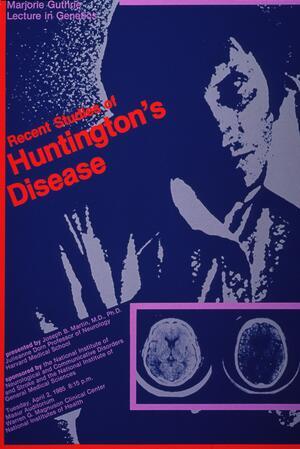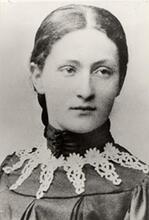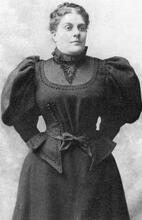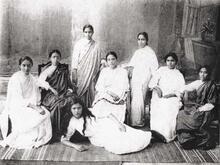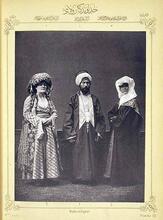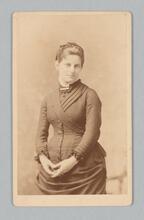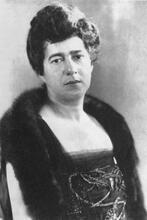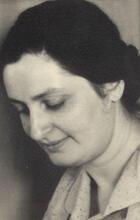Marjorie Guthrie
The daughter of poet Aliza Greenblatt, wife of singer Woody Guthrie, and mother of singer Arlo Guthrie, Marjorie Guthrie became formidable in her own right as an activist for Huntington’s Disease and other genetic and neurological diseases. Guthrie married five times, but it was her second marriage to Woody Guthrie that would shape her life. After Woody’s diagnosis with and subsequent death from Huntington’s Disease, Guthrie devoted herself to advocacy, fundraising, and research for the illness. She earned an appointment to the Advisory Council of the National Institute of General Medical Sciences and was elected to a number of prestigious scientific societies. Guthrie’s work led to the discovery of the genetic marker for Huntington’s. A lecture series at the National Institutes of Health was established in her honor.
Marjorie Guthrie is remembered for her several careers. She was first a dancer and then a teacher. She founded the Woody Guthrie Children’s Fund and Archive (in 1956) to preserve her husband’s works for future audiences. Finally, during the last fifteen years of her life, she became a national advocate for basic biomedical research on the diseases of the chronically ill.
Guthrie’s early life and family
Guthrie grew up in an intellectual atmosphere, influenced by her parents’ commitment to Zionism, socialism, and Jewish welfare. Her mother, Aliza Waitzman Greenblatt, was a Russian-born Yiddish poet, later known to the Guthrie family and their friends as “Bubie.” Aliza Waitzman had been an adventurous young woman. In 1900, she “stole the border” (fled illegally) from the (Yiddish) Small-town Jewish community in Eastern Europe.shtetl Ozarinetz, Bessarabia, and made her way to Philadelphia, where she met her future husband. Aliza Waitzman and Isidor Greenblatt courted at the Radical Library, attending lectures on atheism, anarchism, and philosophy.
Marjorie Guthrie was born in Atlantic City, New Jersey, on October 6, 1917, the fourth of five siblings: Herbert, a merchant marine; Gertrude, an artist; David, a mechanical engineer; and Bernard, a psychiatrist. She graduated from Overbrook High School in Philadelphia. While attending a concert by Mary Wigman, a pioneer in modern dance, Marjorie realized that she had to become a dancer. At eighteen, she won a scholarship to study with Martha Graham at the Neighborhood Playhouse in New York. Under her professional name, Marjorie Mazia, she was featured in Graham’s first company, appearing in “Primitive Mysteries,” “Every Soul is a Circus,” and “American Document,” three of Graham’s early classics. As Graham’s assistant for fifteen years, she was the first member of the group to teach Graham’s technique. Two of her early pupils were Merce Cunningham and Erick Hawkins. By 1950, she had established her own dance school in Sheepshead Bay, Brooklyn.
Marriage to Woody Guthrie
Marjorie Mazia met Woody Guthrie at the Almanac House in Greenwich Village, where hootenannies (folk music sing-alongs) were held. In their small physical size, they resembled each other. They married in 1945 and combined their musical talents and political idealism, calling themselves “World Shakers and World Changers.” Woody was Marjorie’s second husband; she was his second wife and the main support of the family. In between dancing and teaching, she had four children with Woody Guthrie: Cathy (b. 1943), Arlo (b. 1947), Joady (b. 1948), and Nora (b. 1950). Cathy died in an accident at age four on February 9, 1947.
In 1952, Woody’s erratic behavior was diagnosed as symptomatic of Huntington’s disease, inherited from his mother. It was impossible for Marjorie Guthrie to give him the full-time care his condition required. She had to divorce him so that the state would be responsible for supporting his fifteen-year-long hospitalization. She married three more times: to Alfred Addeo (1954), Lou Cooper (1964), and Martin Stein (1974). Her first marriage and those to Addeo and Cooper ended in divorce. Only Stein, who died in 1980, gave her financial security.
Health activism: Huntington’s Disease and more
After Woody died in 1967, Guthrie dedicated her life to educating the medical community and the public about Huntington’s disease. In an effort to help those at risk, she established the Committee to Combat Huntington’s Disease, now called the Huntington’s Disease Society of America. Through reading and intensive study, she gained a profound knowledge of the problems of genetic and neurologic diseases. She earned many honors. She was appointed a lay member of the Advisory Council of the National Institute of General Medical Sciences from 1973 to 1977 and elected to the Society for Neuroscience. She was also made a member of the American Association for the Advancement of Science and appointed to the Research Commission on Huntington’s Chorea of the World Federation of Neurology. Further recognition came with her membership in the New York State Commission on Health Education and Illness Prevention, and in the state’s Genetic Advisory Committee.
Guthrie traveled tirelessly around the world, speaking to Huntington families, medical students, congressional committees in Washington, and legislative assemblies in many states. “It’s a long way from the world of dance to the world of health care,” she said. “And yet, in another way, both depend primarily on communication.” Whenever she called for an appointment with a legislator, she introduced herself by asking, “How old are you?” Relying on the popularity of “This Land Is Your Land” and her son Arlo’s ballad “Alice’s Restaurant,” she would add: “If you are over thirty, I am Woody’s wife. If you are younger, I am Arlo’s mother.”
Legacy and connection to Yiddish culture
With a grant from the Robert Wood Johnson Foundation, Guthrie held meetings in fifteen cities with self-help organizations that were seeking ways they might better share their resources. She acted as consultant to many of those groups, including Alzheimer’s and Tourette Syndrome Associations. Her efforts laid the groundwork for the discovery of the marker for the Huntington gene. After her death on March 13, 1983, a series of lectures by leading scientists was established in her honor at the National Institutes of Health in Bethesda, Maryland.
As a board member and one of the first supporters of the National Yiddish Book Center, in Amherst, Massachusetts, Marjorie Guthrie donated her mother’s collection of first-edition books in Yiddish to the center. The reading room was dedicated to Aliza Greenblatt’s memory. With this commitment, Guthrie reaffirmed her identification with Yiddish culture.
Cohen, Joan Z., Karen Levin Coburn, and Joan Perlman. Hitting Our Stride: Good News About Women in Their Middle Years (1980).
Greenblatt, Aliza. Baym Fenster fun a Lebn [A window on a life] (1966).
Guthrie, Marjorie. Papers. Woody Guthrie Archives, Woody Guthrie Foundation, NYC, and Committee to Combat Huntington’s Disease (CCHD) Newsletters, 1967 to 1983. Huntington’s Disease Society of America, NYC.
Guthrie, Woody. Pastures of Plenty: A Self-Portrait (1989).
Klein, Joe. Woody Guthrie: A Life (1980).

